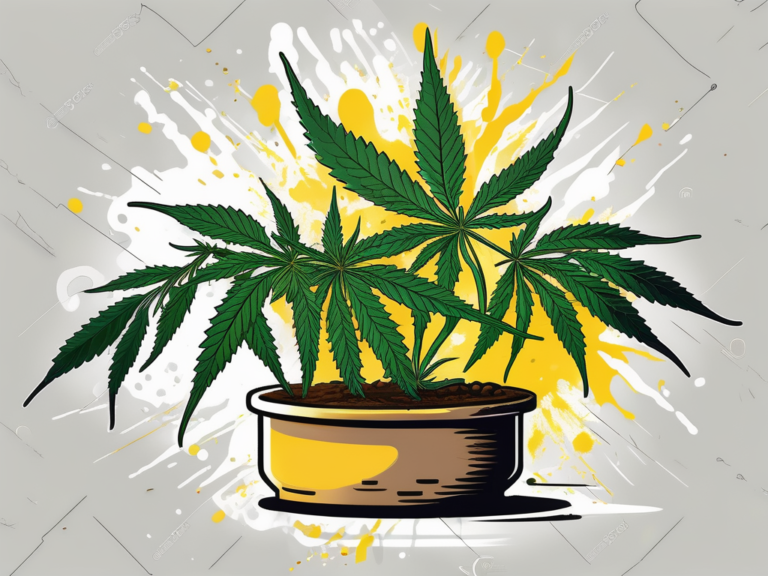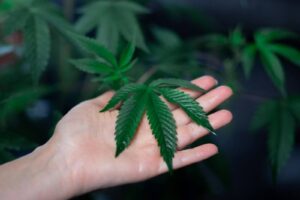Nutrient burn is a common issue faced by cannabis growers that can severely impact the health and productivity of your plants. Understanding what causes nutrient burn, how to identify its symptoms, and how to prevent and treat it is crucial for maintaining a successful cannabis garden. In this comprehensive guide, we will explore everything you need to know about nutrient burn in cannabis.
Understanding Nutrient Burn in Cannabis
Before delving into the causes, symptoms, and prevention of nutrient burn, it is important to have a clear understanding of what exactly it is. Nutrient burn, also known as fertilizer burn, occurs when cannabis plants are exposed to an excessive amount of nutrients. This overload can overwhelm the plant’s ability to uptake and process these nutrients, leading to a range of issues that can impede growth and development. Nutrient burn primarily affects the roots, as well as the overall health of the plant.
When cannabis plants receive an excess of nutrients, they struggle to balance nutrient uptake and utilization, leading to a buildup of unused nutrients. This buildup can disrupt the delicate pH balance within the plant, causing nutrient lockout and nutrient deficiencies. Furthermore, the excessive nutrients can also create a toxic environment for the roots, inhibiting their ability to absorb water and oxygen efficiently.
It is crucial for cannabis growers to closely monitor the nutrient levels in their plants to prevent nutrient burn. One common mistake that leads to nutrient burn is over-fertilization. Growers often believe that providing more nutrients will result in better growth, but this is not the case. Overloading the plants with nutrients can do more harm than good, as it can stunt growth and lead to nutrient imbalances.
Another factor that can contribute to nutrient burn is poor soil quality. Soil that is too compacted or lacks proper drainage can exacerbate the effects of excess nutrients, as the roots struggle to access water and oxygen. Ensuring that the soil is well-aerated and has good drainage can help prevent nutrient burn and promote healthy plant growth.
Causes of Nutrient Burn in Cannabis Plants
There are several factors that contribute to nutrient burn in cannabis plants. Understanding these causes is essential for preventing nutrient burn and ensuring the overall well-being of your plants.
One common cause of nutrient burn is over-fertilization. Many growers mistakenly believe that providing plants with more nutrients will result in better growth and higher yields. However, this is a misconception. Cannabis plants have specific nutrient requirements, and exceeding these requirements can lead to nutrient burn.
Inaccurate pH levels can also contribute to nutrient burn. Cannabis plants thrive in a slightly acidic pH range, typically between 6.0 and 6.5 for soil cultivation. If the pH levels are too high or too low, nutrient uptake can be hindered, leading to nutrient burn and deficiencies.
Another factor that can lead to nutrient burn is poor watering practices. Overwatering or underwatering can both have detrimental effects on cannabis plants. Overwatering can lead to nutrient imbalances in the soil, making it difficult for the roots to absorb nutrients properly. On the other hand, underwatering can cause stress to the plants, affecting their ability to uptake essential nutrients.
Furthermore, environmental factors such as temperature and humidity levels play a crucial role in nutrient uptake and plant health. Extreme temperatures can affect the plant’s metabolism, leading to nutrient deficiencies or burn. High humidity levels can also impact nutrient absorption, as excessive moisture in the air can hinder the plant’s ability to transpire and take up nutrients through the roots.
Identifying Symptoms of Nutrient Burn
Recognizing the symptoms of nutrient burn is crucial for early intervention and mitigating potential damage to your cannabis plants. While symptoms may vary depending on the severity and duration of the nutrient burn, there are several common indicators to watch out for:
- Leaf Tip Burn: This is one of the most noticeable and characteristic signs of nutrient burn. The tips of the leaves appear brown or burnt, curling downwards.
- Leaf Margins: Along with leaf tip burn, you may also observe yellow or brown discoloration along the edges or margins of leaves.
- Leaf Curling: Nutrient burn can cause the leaves to curl upwards or downwards, appearing wilted or deformed.
- Stunted Growth: Excessive nutrient levels can inhibit overall plant growth, resulting in smaller leaves and the plant failing to reach its full potential.
- Necrosis: In severe cases, nutrient burn can lead to the death of leaf tissue, resulting in the development of dark, crispy patches.
It is important to note that these symptoms can also be indicative of other plant issues, such as pest infestations or disease. Therefore, it is crucial to properly diagnose nutrient burn by considering all possible factors and observing the overall health of your cannabis plants.
Furthermore, nutrient burn can often be mistaken for nutrient deficiency, as both conditions can exhibit similar symptoms such as leaf discoloration and stunted growth. However, the key difference lies in the appearance of the affected leaves. Nutrient burn typically affects the tips and edges of the leaves first, while nutrient deficiency tends to cause uniform discoloration throughout the entire leaf.
Additionally, it is essential to maintain a balanced nutrient regimen for your cannabis plants to prevent nutrient burn. Overfeeding or using incorrect nutrient ratios can easily lead to nutrient imbalances and subsequent burn. Regularly monitoring the pH levels of your soil or growing medium can also help prevent nutrient uptake issues that may result in nutrient burn.
Preventing Nutrient Burn in Your Cannabis Garden
Prevention is always better than cure when it comes to nutrient burn. By implementing the following practices, you can significantly reduce the risk of nutrient burn in your cannabis garden:
- Proper Nutrient Selection: Choose high-quality nutrients specifically formulated for cannabis cultivation. These nutrients are designed to meet the unique needs of cannabis plants and provide the essential elements without risking nutrient burn.
- Follow Nutrient Schedule: Adhere to the recommended dosage guidelines provided by the nutrient manufacturer. Avoid the temptation to exceed these guidelines, as it can have detrimental effects on your plants.
- Monitor pH Levels: Regularly test the pH levels of your growing medium and adjust as necessary to ensure optimal nutrient uptake. Maintaining the correct pH range is crucial for preventing nutrient lockout and burn.
- Flush Soil: Periodically flush the soil to remove any excess nutrients and maintain a clean growing medium. This practice helps prevent nutrient buildup and potential nutrient burn.
- Observe Plant Health: Regularly inspect your cannabis plants for early signs of nutrient burn. Catching the issue early allows for prompt intervention and aids in preventing further damage.
Treating Nutrient Burn in Cannabis Plants
If nutrient burn occurs despite your prevention efforts, prompt action is necessary to salvage your cannabis plants. Here are some effective strategies to treat nutrient burn:
- Flush the Soil: To remove excess nutrients, flush the soil with pH-balanced water. This helps restore the pH balance and eliminate accumulated salts that are causing nutrient burn.
- Adjust Nutrient Schedule: Reduce or temporarily stop nutrient feeding to allow the plant’s roots to recover and restore their natural nutrient balance.
- Reassess pH Levels: Double-check your pH levels to ensure they are within the optimal range. Adjust as necessary to aid in overall nutrient absorption and minimize nutrient burn.
- Provide Adequate Watering: Proper watering practices are essential for nutrient uptake and overall plant health. Water your cannabis plants thoroughly but avoid overwatering, which can exacerbate nutrient burn.
- Trim Affected Leaves: If the damage is localized, carefully trim the affected leaves to prevent further spread of the burn and redirect the plant’s energy towards healthy growth.
The Role of pH in Nutrient Burn
pH plays a vital role in nutrient absorption and is closely linked to the occurrence of nutrient burn in cannabis plants. Monitoring and maintaining the pH levels within the appropriate range is crucial for ensuring optimal nutrient uptake and preventing nutrient burn. A well-balanced pH allows for the efficient breakdown and absorption of nutrients, ultimately promoting healthy growth and development.
pH imbalances can lead to nutrient lockout, where certain essential nutrients become unavailable to the plant. Consequently, the plant experiences deficiencies despite the presence of an excess of nutrients. This imbalance can manifest as nutrient burn symptoms, further emphasizing the importance of maintaining pH levels within the optimal range.
Nutrient Burn in Different Growth Stages of Cannabis
The impact and severity of nutrient burn can vary depending on the growth stage of your cannabis plants.
In the vegetative stage, nutrient burn can hinder overall plant development, leading to stunted growth and reduced vigor. Damaged leaves may not recover fully, affecting the plant’s ability to efficiently carry out photosynthesis and nutrient absorption.
In the flowering stage, nutrient burn can be particularly damaging, as it may impact bud development and quality. The onset of nutrient burn during this critical stage can lead to reduced yields and compromised potency.
It is essential to monitor your plants closely throughout their growth stages and make adjustments to nutrient levels accordingly. Implementing a well-balanced nutrient feeding schedule specific to each stage can help minimize the risk of nutrient burn and maximize overall plant health and productivity.
By understanding the causes, identifying the symptoms, and taking proactive measures to prevent and treat nutrient burn, you can ensure the optimal health and productivity of your cannabis garden. Remember, knowledge and attentive care are the key to cultivating thriving cannabis plants that flourish from seed to harvest.




